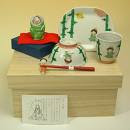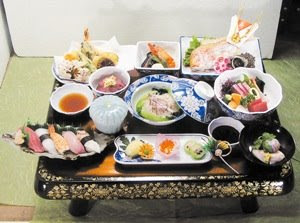:::::::::::::::::::::::::::::::::::::::::::::::::::::::::::::::::::::::::::::::::::::::::::::::::::::
Dinner Tray (zen 膳)
***** Location: Japan
***** Season: Non-seasonal Topic
***** Category: Humanity
*****************************
Explanation
Food tray, dinner tray


Laquer set ................ Arita Pottery set
Since olden times, Japanese lived on tatami mats and served food "on the floor" on a special tray.
Special types are used in temples too, see LINK below.
The trays are made of light wood with a special water-repellant finish or a laquered surface. These trays are a very special part of the traditional Japanese food culture.
The Daimyo lords of old used to have specially decorated trays with their family crest.
Here is a sample with food :

Here is another type, tray on a box :

This is a BOX TRAY (hakozen 箱膳 hako-zen, hako zen):

Sample with food served on it

The households of old used to have one box for each family member. The plates, dishes and chopsticks for each one could be stored inside the box when not used and all the boxes could be stacked easily in the kitchen.
In the farmhouse where I live now, we found sets of these tray boxes for almost 50 people! We sometimes use them when there are many visitors and we eat on the tatami mats.
Gabi Greve, Okayama, Japan
*****************************
Worldwide use
*****************************
Things found on the way
. Daruma san and the tray (bon 盆)
ぬり盆にころりと蝿の滑りけり
nuribon ni korori to hea no suberikeri
a lacquered tray--
whoops!
the fly slips
Tr. David Lanoue
. Kobayashi Issa 小林一茶 in Edo .

- Haiga by Nakamura Sakuo -
:::::::::::::::::::::::::::::::::::::::::::::::::::::::::::::::::::::::::::::::::::::::::::::::::::::
In a Japanese Temple
飲食 供養
Food Offerings and Bowls
Kukai no Zen 空海
Monks carrying the food for Kobo Daishi 空海の膳
Special ZEN for a Daruma Celebration

Temple Enpuku-Ji
Bentoobako ― Lunchbox with Daruma
*****************************
HAIKU
Kobayashi Issa
夕飯の膳の際より青田哉
yuumeshi no zen no kiwa yori aoda kana
at the dinner
tray's edge...
a green rice field
This haiku has the prescript, "Rural cottage."
Shinji Ogawa explains that a zen (dining tray) is about one foot by one foot with five-inch legs. Sakuo Nakamura pictures Issa "taking dinner in a cottage just beside a green rice field. He looks at his square tray, where the cooked rice has been placed. Suddenly, his imagination jumps so that the tray is continuing on into the rice field, which is also square." Sakuo admires "the jumping power of Issa's imagination and the wide extent of his viewing, that spreads from the narrow cottage to the broad field."
もともとの一人前ぞ雑煮膳
motomoto no ichininmae zo zooni zen
like in the beginning
just one helping...
zoni on the table
大雪や膳の際から越後山
ôyuki ya zen no kiwa kara echigo yama
heavy snow--
from the dinner tray's edge
Echigo mountains
Tr. David Lanoue

Haiga by Nakamura Sakuo
Haiku about ECHIGO
:::::::::::::::::::::::::::::::::::::::::::::::::::::::::::::::::::::::::::::::::::::::::::::::::::::
Issa's perspective is wonderful, and so thoughtfully expressed in short poems. I am encouraged to add one more:
at the dinner
tray's edge —
flooding of rice fields
The rice fields need plenty of water to grow. Therefore , there will always water flooding the roots of rice pods. Best regards,
Kumarendra Mallick
Hyderabad, India, Summer 2008
:::::::::::::::::::::::::::::::::::::::::::::::::::::::::::::::::::::::::::::::::::::::::::::::::::::
Kitsuki bon 朽木盆 tray from Kitsuki
laquered round trays of the Edo period, mostly with a chrysanthemum or flower pattern
kuchiki, kitsuki くちき【朽ち木】is dead wood.
Kitsuki is also the name of a region in Shiga prefecture, where these trays were made.

盃の下ゆく菊や朽木盆
sakazuki no shita yuku kiku ya Kitsuki bon
below the sake cup
there is a chrysanthemum -
tray from Kitsuki
Written in 1675, 延宝3年, Basho age 32.
He took the inspriation from an old song, Yooroo 養老 Yoro.
The sake in the small cup is overflowing rapidly and becomes the famous waterfall of Yoro. Its flow looks like the chrysanthemums flowing in the river.
MORE - hokku about sake cups and drinking by
. Matsuo Basho 松尾芭蕉 - Archives of the WKD .
Yōrō Falls (養老の滝, Yōrō no Taki) is a waterfall in Yōrō Park located in the town of Yōrō, Yōrō District, Gifu, Japan.
The water from the falls is praised for its high quality, and is mentioned in a legend that tells the story of a dedicated son who offered the water, which tasted like sake to his ailing father who, upon drinking it, was revive.
The Empress Genshō, who visited this area, renamed the period of her reign "Yōrō" saying, "Rei Springs are beautiful springs. And so doth nourish the old. Perhaps it be the spirit of the waters. I do [hereby] give amnesty under heaven, and fix the third year of the Reiki (era) anew to year 1 of the Yōrō (era)."
© More in the WIKIPEDIA !
There are a few other waterfalls in Japan with this name.
quote
Yooroo 養老(ようろう)Yoro - A Noh Play

It was the time of the twenty-first Emperor Yūryaku. His majesty was informed of a rumor of a miraculous spring in Motosu of Mino Province (Present-day Gifu Prefecture) and dispatched an imperial investigator to find out about it. At the site, the investigator meets an old woodcutter and his son who had found the spiritual spring. When the imperial investigator asks, they tell the story of how they found the spring and how they started to call it "Yōrō no Taki Waterfall."
When the parents drank the water that his son had found, the old parents felt mentally and physically refresh and vigorous. They therefore named the fall "Yōrō (taking care of elders)." In addition, the old man points the imperial investigator to the basin of the fall, introduces historical stories related to longevity and water, and praises the medicinal benefits of the waters of the Yōrō Fall. When the investigator is pleased to be able to give a great report to His Majesty, music is heard from the sky and flowers start to fall.
With these auspicious signs, a deity of a mountain, who claims to be an incarnation of Willow Bodhisattva, appears and dashingly dances to bless the peace of the world.
source : www.the-noh.com/en
*****************************
Related words
***** food tray for the dolls, hina no zen 雛の膳
***** food tray for the Bon festival, bon no zen 盆の膳
***** . honzen 本膳 lit. the main tray
Formal Japanese Food Arrangement on a Banquet Tray
honzen ryoori 本膳料理
:::::::::::::::::::::::::::::::::::::::::::::::::::::::::::::::::::::::::::::::::::::::::::::::::::::
[ . BACK to WORLDKIGO . TOP . ]
[ . BACK to DARUMA MUSEUM TOP . ]
:::::::::::::::::::::::::::::::::::::::::::::::::::::::::::::::::::::::::::::::::::::::::::::::::::::
お膳の話、沢山有難うございます。
ReplyDelete実生活でお膳で食べた事は、もう遥か昔のことです。
田舎の家の蔵に何十人分のお膳があった事を思い出します。
今は役場に寄贈しました。
私の前の絵が出て来てとても楽しかったです。
何時も有難うございます。
sakuo
Gabi, another interesting topic. The closest parallels I can think of are hospital trays and airline food trays. At home some people eat breakfast in bed, and some bed(room) designers include a kind of tray table with wheels as part of the general furniture. I think it's a simple pleasure to be served a food tray, no matter how simple the food.
ReplyDeletein a vase
on the food tray
small daisies
It couldn't come at a better time. I was trying to make a similar division, or cut, with an end of spring/beginning of summer haiku. There was a very special mist over a wheatfield dividing sunrise and earth. These are very striking divisions of perspective that, it seems, only Issa had the razor to cut.
ReplyDeleteThank you for your wealth of knowledge and unlimited passion, it helps us from afar.
T.K.
Kobayashi Issa
ReplyDelete膳先の猫にも年をとらせけり
zen saki no neko ni mo toshi o torase keri
I make even the cat
by my New Year's tray
get a year older
This hokku is from the tenth month (November) of 1822, the year Issa turned sixty, considered to be a ripe old age in his time. Living beyond sixty was generally regarded to be a blessing, and in this hokku Issa seems to have mixed emotions about ageing. When he wrote the hokku he was traveling around to various students' houses near his hometown, so this seems to be a hokku based on a memory.
In the hokku it is New Year's Eve, a time that is both the last night of the year and the beginning of the new year. According to the Chinese lunar calendar, each new day begins in the middle of the night, during the Hour of the Rat, but in the old Japanese shamanic religious view of time each new day begins when darkness falls, and the new year begins earlier on New Year's Eve, not at midnight. Likewise, the most sacred aspects of a Shinto festival begin with ceremonies the evening before the public festivities on the following day. In contemporary Japan, which follows the Gregorian solar calendar, the new year starts at midnight, and a special New Year's feast is eaten on the first day of the new year, but in Issa's time the New Year's feast was usually eaten the evening before, when the new year was believed to actually begin. At the feast many kinds of special New Year's food were served, and in the area around Issa's hometown salted salmon was one of the main dishes, along with various kinds of seafood, seaweed, rice cakes, and perhaps a little sake. The food, placed on individual trays that stood on short legs, was first offered, along with many prayers, to the god of the new year, and only after the god had eaten it could humans also eat it. Sharing this special meal together with the god was perhaps the most important household ceremony of the year, and only afterwards did people visit local Shinto shrines and Buddhist temples.
In Issa's time birthdays were comparatively unimportant, since everyone got a year older at New Year's, so the New Year's Eve feast was also a collective birthday party at which everyone congratulated everyone else. At this stage in his life, Issa is probably the oldest male present at the ceremony, so after making prayers to the god of the new year and inviting the god into his house for the year, he probably says words of blessing and congratulations to his wife and perhaps to some relatives -- and silently to himself. He also congratulates the cat, which sits near his tray and no doubt receives some of the delicious fish on it. Getting a year older at New Year's is a human custom, but by including the cat among the family members and sharing blessings and food with it, Issa says he has caused even this non-human family member to get one year older as well. To make someone older (toshi o torasekeri) often has slightly negative connotations, as if someone has burdened or bothered someone else and caused him or her to age prematurely, but because it is New Year's there seems to be gentle humor in Issa's use of this verb to express a kind of apology to the cat. Issa congratulates the cat and prays for its happiness and health during the coming year, but he reminds the cat that it, too, is now subject to ageing just like the other members of the family.
Chris Drake
daidokoro 台所 the Japanese kitchen
ReplyDelete- Introduction -
- - - - part of the entry about
. Interior Design - The Japanese Home .
Kappa the water goblin
ReplyDeletelending trays and bowls
Zenwanbuchi 膳椀淵 "river pool for trays and bowls".
ending お膳 O-Zen trays
.
Legends from
Aichi and Fukushima
.
Yooro no Taki 養老の滝 Yoro no Taki Waterfall
ReplyDeleteand
Yooro Sennin 養老仙人 Yoro Sennin, the Immortal
https://gokurakuparadies.blogspot.jp/2018/04/sennin-07-yoro.html
.